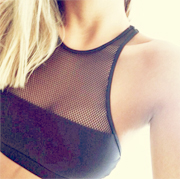Shoe business
date: 2012-11-16  time: 22:52:12
time: 22:52:12
 time: 22:52:12
time: 22:52:12 The most important piece of gear for a runner besides your body is a good pair of running shoes. Choosing the wrong shoes can lead to improper running form, which may eventually lead to injuries. You may also suffer from black toenails, blisters, and ankle chafing. It’s a risky business because shoes can be quite expensive, so you want to be sure that you’re choosing what’s best for your individual case. Staring blankly at a big wall of shoes can be a bit intimidating and overwhelming, and it’s very easy to get sucked into a pair of shoes because they look cute, speedy, or cool. You’re goal should be to find a shoe that will offer adequate shock, absorption, motion control, flexibility, and durability. Yes, this is just as important for beginners as it is for seasoned runners. So, no running in Keds, skate shoes, flip flops, or any other shoe not meant for the sport of running just isn’t going to cut it. A good pair of running shoes should last from about 500 to 800 kilometers (300 to 500 miles), and it’s dependent on a lot of factors.
Pronation is an important concept to understand when choosing a pair of running shoes. There are 3 different types of pronators.

Normal pronation: The outside part of the heel makes initial contact with the ground. The foot “rolls” inward about fifteen percent, comes in complete contact with the ground, and can support your body weight without any problem. The rolling in of the foot optimally distributes the forces of impact. This movement is called “pronation,” and it’s critical to proper shock absorption. At the end of the gait cycle, you push off evenly from the front of the foot.
Overpronation: As with the “normal pronation” sequence, the outside of the heel makes the initial ground contact. However, the foot rolls inward more than the ideal fifteen percent, which is called “overpronation.” This means the foot and ankle have problems stabilizing the body, and shock isn’t absorbed as efficiently. At the end of the gait cycle, the front of the foot pushes off the ground using mainly the big toe and second toe, which then must do all the work.
Underpronation: Again, the outside of the heel makes initial contact with the ground. But the inward movement of the foot occurs at less than fifteen percent (i.e., there is less rolling in than for those with normal or flat feet). Consequently, forces of impact are concentrated on a smaller area of the foot (the outside part), and are not distributed as efficiently. In the push-off phase, most of the work is done by the smaller toes on the outside of the foot.
Now that you understand pronation, it’s time to figure out your foot type. By determining your arch height, it’s that much easier to determine your pronation. The easier way to figure out your arch height is by using the “wet test.” Wet the bottom of your bare foot, and then make a foot print on a flat, dry surface. You can use a sidewalk, but a piece of construction paper will also do the trick.

A - Normal (medium) arch: If you see about half of your arch, you have the most common foot type and are considered a normal pronator. Contrary to popular belief, pronation is a good thing. When the arch collapses inward, this “pronation” absorbs shock. As a normal pronator, you can wear just about any shoe, but may be best suited to a stability shoe that provides moderate arch support (or medial stability). Lightweight runners with normal arches may prefer neutral-cushioned shoes without any added support, or even a performance-training shoe that offers some support but less heft, for a faster feel.
B - Flat (low) arch: If you see almost your entire footprint, you have a flat foot, which means you’re probably an overpronator. That is, a micro-second after footstrike, your arch collapses inward too much, resulting in excessive foot motion and increasing your risk of injuries. You need either stability shoes, which employ devices such as dual-density midsoles and supportive “posts” to reduce pronation and are best for mild to moderate overpronators, or motion-control shoes, which have firmer support devices and are best for severe overpronators, as well as tall, heavy (over 75 kg [165 pounds]), or bow-legged runners.
C - High arch: If you see just your heel, the ball of your foot, and a thin line on the outside of your foot, you have a high arch, the least common foot type. This means you’re likely an underpronator, or supinator, which can result in too much shock traveling up your legs, since your arch doesn’t collapse enough to absorb it. Underpronators are best suited to neutral-cushioned shoes because they need a softer midsole to encourage pronation. It’s vital that an underpronator’s shoes have no added stability devices to reduce or control pronation, the way a stability or motion-control shoe would.
Once you’ve determined your foot type and degree of pronation, what’s next? It’s time to shop! But, where do you begin with hundreds upon hundreds of choices? For starters, let’s take a look at the anatomy of a running shoe.

Upper: The part of the shoe that wraps around the top of the foot.
Heel counter: A firm cup that is encased in the upper and surrounds the heel. It controls rearfoot motion.
Midsole: The cushioning layer between the upper and the outsole. It is usually made of ethylene vinyl acetate, polyurethane, or a combination of the two. Dual-density midsoles have a former material on the inside of the shoe. It helps limit pronation. Many shoe companies also put proprietary technologies in their midsoles, such as air, gel, and plastics.
Outsole: The undersurface of the shoe, usually made from carbon rubber.
There are different types of shoes that support different runners. Here is a brief breakdown.
Stability shoes: Stability running shoes are designed for people who have normal or medium arched feet. When running, the foot strikes the ground at the middle to outside of the heel. The weight then travels along the foot and rolls slightly inward on to the ball of the foot and leaves through the toes. This is a totally natural running action for the normal foot type. Stability running shoes support the running action as the runner has a normal pronation or foot rotation when running. These shoes are still required and will enhance the running action far better than a lateral motion shoe such as basketball or tennis shoes. The stability shoe has elements of all types of running shoes in them. Some rigidity is required but not too much so normal pronation is allowed. Some cushioning is required to absorb the shock. These elements will help prevent injuries that the wrong footwear can cause.
Motion-controlled shoes: Motion-control running shoes are designed for people who have low arches or flat feet, these are feet with a very low arch if any arch at all. Runners with this foot type when running will usually strike the ground on the outer edge of the foot. The weight then transfers from the heel up the foot and the foot excessively rotates inward, this is called overpronation. This needs a specialist running shoe as overpronation can cause injuries as the weight transfers unnaturally. Motion-control running shoes help a runner with this foot type as the shoe is more rigid and prevents the excessive rotation. It does this by having a medial post in the sole, the shoe will have a slightly wider sole and be slightly bulkier to prevent the excessive rotation. The runners action is not affected but they may notice less pain and strain in the feet after the run and will see less injuries in the long term.
Cushioned shoes: Cushioned running shoes are designed for people who have high arched feet. Their foot print will leave a thin band at the edge of the foot. Some will not have a band at all and the arch will expand the whole way across the foot. When running the weight travels from the heel strike along the outer edge of the foot and through to the small toes which bare the brunt of the lift off. The foot has barely any rotation and this is called underpronation or supination. The lack of rotation creates a lot of shock on the joints. The cushioned running shoe will absorb this shock. The shoe will be flexible and allow more natural pronation as it contains no devices like medial posts found in other shoes to prevent rotation. Runners with this foot type will find they get shin splints and knee problems allot more than other runners lack of shock absorption their foot type causes.

If you’re still unsure and confused about this process, check out a specialty running store. A lot of running stores have “shoe experts,” and they can help lead you in the right direction. They should provide you with a few choices to try on. Some stores may even allow you to take different shoes for a quick test run. Most stores are pretty flexible when it comes to exchanges/returns. If you find that your shoes are causing problems, take them back and try something else. It’s hard to be completely certain that a shoe is right for you unless you try them.
Questions that a good salesperson should ask are:
- How long have you been running?
- How much mileage are you doing?
- Where do you do most of your running?
- How much do you weigh?
- Are you aware of any foot problems, such as flat feet or over-/underpronation?
Key pointers when shoe shopping:
- Wear the socks that you plan on wearing while running. If you don’t have any, buy some moisture wicking socks beforehand.
- Your feet will expand while running, so opt for 1/2 to 1 size up from your normal, everyday shoes. You should aim to have at least 1 thumb width between your toes and the tip of the shoe. The key is to have the shoes fit not too snug, but also not too loose as to where your feet are sliding around.
- Both of your feet should be measure because a lot of people, including myself, have one foot that is slightly larger than the other. You should be fitted for the larger foot.
 Frida
Frida
Hej! vart är de rosa skorna köpta? :)
2012-11-19  14:14:07
14:14:07
 14:14:07
14:14:07
Frida
Hej! vart är de rosa skorna köpta? :)
2012-11-19  14:14:07
14:14:07
 14:14:07
14:14:07







